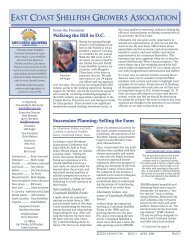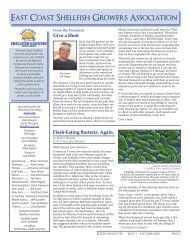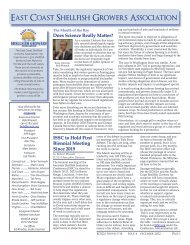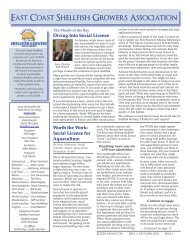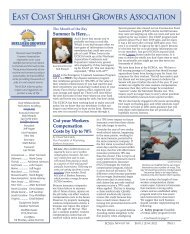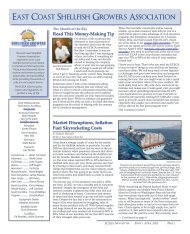East Coast Shellfish Growers Association Newsletter June 2023
This edition has stories on the long awaited return of the annual Walk the Hill event, recaps of the Interstate Shellfish Sanitation Conference and the National Shellfish Association's session on birds and sanitation, Nature Conservancy and Pew expansion of oyster restoration and resiliency initiative, passage of the Jones Act exemption for shellfish farmers, an update on the Gulf Coast chapter,
This edition has stories on the long awaited return of the annual Walk the Hill event, recaps of the Interstate Shellfish Sanitation Conference and the National Shellfish Association's session on birds and sanitation, Nature Conservancy and Pew expansion of oyster restoration and resiliency initiative, passage of the Jones Act exemption for shellfish farmers, an update on the Gulf Coast chapter,
Create successful ePaper yourself
Turn your PDF publications into a flip-book with our unique Google optimized e-Paper software.
—Continued from page 5<br />
Birds and Sanitation<br />
While water samples taken 70<br />
feet from the lease just a few<br />
days prior had tested clean,<br />
meat samples taken after the<br />
illnesses were reported showed<br />
quite high levels of the bacteria,<br />
demonstrating just how challenging<br />
sampling can be. Once<br />
the grower sank the floating gear<br />
it took less than 18 days for the<br />
meats to test clean.<br />
Steve Jones of the University<br />
of New Hampshire reported on<br />
AQUAMESH®<br />
PREMIUM QUALITY MARINE-GRADE WIRE PRODUCTS<br />
PROUDLY MADE IN THE USA<br />
ECSGA <strong>Newsletter</strong><br />
years of microbial source-tracking<br />
work where he observed<br />
bird-related microbial contamination<br />
in most samples. The<br />
fact that there have been only a<br />
handful of illnesses related to<br />
shellfish consumption hammers<br />
home the fact that the prevalence<br />
of human pathogens in<br />
wild bird waste is quite rare.<br />
Dr. Rachel Nobel of the University<br />
of North Carolina emphasized<br />
the need for more studies.<br />
She pointed out that molecular<br />
techniques can be useful in<br />
identifying whether observed<br />
www.riverdale.com<br />
Page 10 Issue 2 june <strong>2023</strong><br />
FC come from a human source,<br />
where risk is well established,<br />
or from wildlife, where risk is<br />
poorly understood. Unfortunately,<br />
most molecular techniques<br />
only indicate the presence of<br />
genes, but cannot tell you if the<br />
pathogens are viable, or if they<br />
have died baking in the sun on a<br />
black float. Furthermore, unless<br />
you culture the pathogens and<br />
identify the strains, it is usually<br />
difficult to say whether they<br />
pose a threat to humans at all,<br />
since most pathogens are highly<br />
species-specific.<br />
Chris Schillaci, NOAA’s Regional<br />
Aquaculture Coordinator<br />
in the Greater Atlantic Region,<br />
summarized the 14 pages of<br />
guidance that had just been adopted<br />
at the March ISSC meeting<br />
(pending FDA approval).<br />
In developing the guidance, the<br />
Aquaculture Commitee of the<br />
ISSC tried to provide states with<br />
a range of options to help them<br />
determine how best to manage<br />
bird problems, encouraging<br />
state regulators to consider<br />
tidal flow and depth before<br />
mandating expensive repellent<br />
measures and mandatory resubmergence<br />
protocols.<br />
Bobbi Hudson, executive director<br />
of the Pacific <strong>Shellfish</strong> Institute,<br />
did a magnificent job summarizing<br />
many of the known<br />
unknowns, drawing on a number<br />
of publications that describe<br />
the rarity of human pathogens<br />
in wildlife waste, and the challenges<br />
of estimating risk in a<br />
sea of uncertainty. Clearly, the<br />
risk of contamination in areas<br />
with massive 12-foot tides (like<br />
Washington State) is not the<br />
same as it might be in an area<br />
like Maryland or the Gulf of<br />
Mexico, where 3-foot tides are<br />
more the norm. Hudson quoted<br />
a recent meta-analysis indicating<br />
that “data are too limited and biased<br />
to make data-driven recommendations<br />
for managing wild<br />
birds to reduce enteric pathogen<br />
spillover to people.” Her presentation<br />
contains a lot of useful<br />
information and resources and is<br />
posted at ECSGA.org 3 .<br />
I remain hopeful that the new<br />
molecular tools allowing for<br />
source tracking on coliform<br />
samples will eventually help<br />
regulators consider ways to<br />
avoid closing growing areas<br />
when high FC counts can be<br />
tracked to birds and when human<br />
sources can be ruled out. I<br />
am also confident that growers<br />
will continue to develop costeffective,<br />
workable repellents to<br />
deter birds in areas where low<br />
tidal flushing indicates the need<br />
for such measures.<br />
Notes<br />
URI/RI DEM<br />
Since birds are smart and quickly<br />
acclimate to deterrents, you may<br />
have to use a variety of approaches<br />
and mix them up. These could<br />
include monofilament line, zip-tie<br />
“ticklers,” scare kites, sprinklers,<br />
OysterGro ® BirdAway hawk systems,<br />
wire tufts and gull sweeps.<br />
1. ecsga.org/wp-content/<br />
uploads/<strong>2023</strong>/04/MullerNSA-<br />
<strong>2023</strong>BirdsAqPPT.pdf<br />
2. ecsga.org/bird-interactions<br />
3. ecsga.org/wp-content/uploads/<strong>2023</strong>/04/BirdsOnFloatingGearNSA<strong>2023</strong>.pdf




